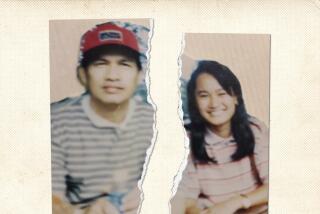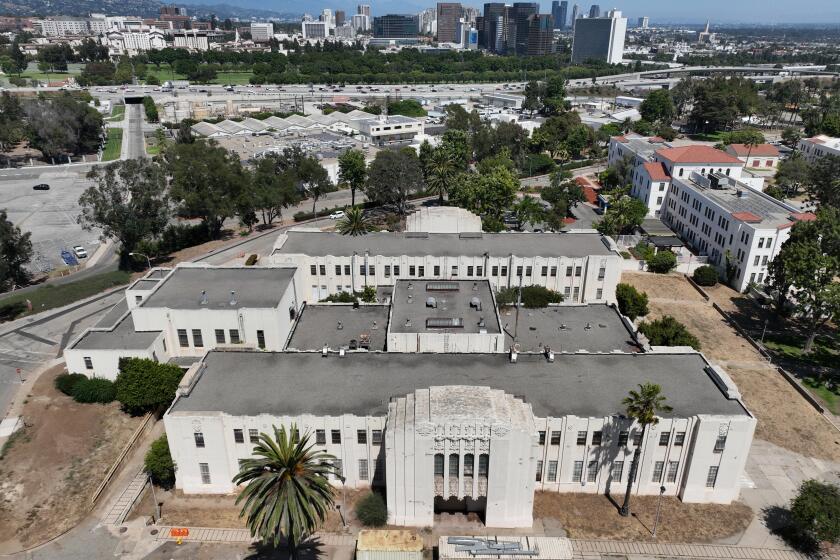A Slow Return to Old Grandeur
The effort to restore the Breed Street Shul’s stained-glass windows has required artistry, patience and some detective work. Not to mention biohazard suits.
The windows -- centerpiece of the main shul building -- are being renovated as part of an overhaul of the Boyle Heights landmark. Workers at the shul, or synagogue, installed two renovated half-moon windows this month as a test fit. The others will be mounted as they are completed over the next several weeks.
The two buildings of the shul, which date from the early 20th century, are remnants of a once-large Jewish population, replaced now by a thriving Latino community.
Once it is finished, the shul will serve local residents as a cultural and educational space.
“We think it’s a great bridge between the Jewish community and the Latino community,” said Stephen Sass, president of the Jewish Historical Society of Southern California, which owns the buildings.
The windows were restored for $300,000, a fraction of the $1.1-million cost of the first phase of reconstruction, which included lead-paint removal and a new roof and ceiling.
The second phase of the project, for which funds are still being raised, will cost about $5 million. It will pay for the completion of seismic retrofitting, artwork conservation and other items.
Until more money comes in, the shul will wait, semi-completed. The new mint green ceiling and the bright light streaming through colored windows contrast with filthy wood slats on the floor in need of repair and peeling murals waiting to be preserved so they don’t deteriorate further.
The city declared the main shul building, at 247 N. Breed St., unsafe after the 1987 Whittier Narrows earthquake. Congregants moved their worship services to the back building, then abandoned the shul entirely in 1996 because of dwindling attendance. The buildings soon fell victim to vandals and the elements.
The Jewish Historical Society took over the property in 1998 and began reconstruction last fall.
Judson Studios, a stained-glass shop in Los Angeles, took on the task of cleaning, renovating and in some cases re-creating the shul’s 47 windows. Though no records link Judson to the shul, director David Judson said his studio -- itself on the National Register of Historic Places and established in 1897 -- might have made the original windows.
Regardless, “with our history in L.A., we like to work on other historical places,” Judson said.
When Paul Martinez, an independent contractor who removed the windows, began work in January, he found them lighted only by a giant hole in the roof. Some panes had been broken by bricks, and almost all were blackened with dirt and streaked with bird droppings.
“The pigeons had taken over,” Judson said.
The birds had entered through a 300-square-foot gash in the roof and had marked their territory well before being shooed away.
“There was piles of it around the walls,” Martinez said, “big piles, 6 inches deep in some areas, and 2 or 3 feet long.”
That’s where the biohazard suits come in. Before work could begin, Martinez took a two-hour class on hazardous materials.
“The stuff is almost lighter than air, so the spores tend to fly in the air, and that’s what you have to avoid breathing,” he said, or risk getting a long and nasty cold. Martinez put on a white biohazard suit, a mask and gloves. He sprayed his work boots with bleach. He also sprayed the windows with bleach.
In the main sanctuary, Martinez removed 12 sets of windows, 10 of which consisted of two rectangular panes topped by a half-moon shaped window with the Star of David. The remaining two consist of the half-moon and one rectangular panel.
And there were the bees. Honeycombs covered two of the half-moon windows.
“There was honey still dripping and oozing from them,” Martinez said. “We kind of scraped what we could away, and it was still dripping on the floors.”
Back at Judson Studios, the windows were soaked with ammonia and rinsed with a garden hose.
Of the 22 amber-colored, rectangular panels, which measure 56 inches wide by 67 inches tall, 14 were a complete loss and had to be re-created from scratch.
The 50-pound windows were scrubbed and scraped of dirt with a steel brush and a razor blade. The texture and color of the individual windowpanes resemble those of plastic cups often used in restaurants.
Pieces of colored glass around the edges embellish the amber windows, which apparently were planned on a budget.
“It’s cheaper to do simple rectangles than all kinds of designs,” Judson said. “It’s an old style of glass that they don’t use anymore.”
The original glass can’t be re-created, but Judson found a similar type of glass at a supplier in Stanton.
The new glass around the edges -- in green, blue, purple, red and tan -- came from Kokomo Opalescent Glass in Indiana, which determined from samples from the shul that the company probably had made the original glass. A happy coincidence.
“The building and the project/effort to restore it is extraordinary,” Jean Farnsworth, a consultant on stained-glass restoration, said in an e-mail. Farnsworth, a historian who advised on the project, called the windows “fine examples of American stained glass from the first quarter of the 20th century.”
Their most unusual elements were clear panes painted with symbolic representations of the 12 Tribes of Israel, she said. “When restored, the building, on the National Register of Historic Places, will both serve the community and serve as a visual reminder of a significant element of America’s cultural heritage,” she wrote.
Five of the original paintings survived, though they are largely faded by sunlight and weather. A picture of a sixth painting exists, but the others will have to be created in the style of the originals.
“Over time, the paints have deteriorated badly so that only a ghost image remains,” said Mary Clerkin Higgins, a conservator and artist who is restoring the paintings. “What I’m trying to do is figure out what it was.”
Under a microscope, Higgins examined faint brush strokes and color remnants of the tribe of Asher, represented by sheaves of wheat. She saw hints of greens and blues of the old enamel paint, which is made of ground-up glass.
After removing the lead frame, she made a telling discovery.
“Underneath the perimeter leads, there are still intensely colored enamels,” Higgins said. She found yellow, green, purple and blue. “We will be able to get much closer to what was there originally.”
She cannot paint on the old glass because it cannot be refired -- the ultimate goal is conservation -- so Higgins is painting the missing story onto a piece of glass that will sit behind the old one.
The 400-member Jewish Historical Society is still looking for funds to complete the seismic renovations on the shul. Most of the money for the project has come from the Federal Emergency Management Agency, the state of California, the Jewish Federation and the Jewish Community Foundation of Los Angeles, Sass said. The society recently received a grant from FEMA to retrofit the back building.
On Tuesday, Mark Green, construction superintendent for the project, climbed a ladder in the balcony to see whether a restored window would fit.
Green recalled that conditions in the shul had once become so awful that even homeless people wouldn’t camp out there. “It smelled like death and destruction,” he said, adding that workers had found animal skeletons in the building.
The smells are gone, and now, under the new ceiling, Green stood on his ladder as foreman Joe Crilly handed up a half-moon windows. Green slipped it perfectly into place.
“It fit,” he said, sounding mildly surprised.
He stepped down from the ladder and moved it away. Hands on his hips, standing about 15 feet away, Green surveyed the opalescent hues, brighter in the hazy morning sunlight.
“That is awesome.”
More to Read
Sign up for Essential California
The most important California stories and recommendations in your inbox every morning.
You may occasionally receive promotional content from the Los Angeles Times.










